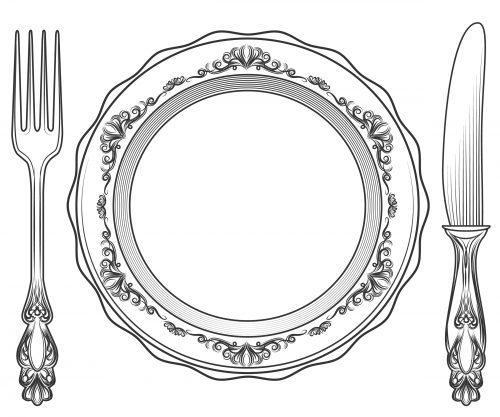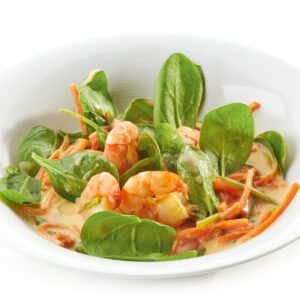
Should we be eating just like our grandmother did, or are some of her habits best left in the past? Stephanie Osfield looks back in time.
Flashback 50 or 70 years ago to when your grandmother, or perhaps your great-grandmother, was rustling up the evening meal – to a time when cooking was a completely different affair.
She’d shell peas by hand, boil rather than steam the broccoli and make all sauces from scratch. Meat and three veges were standard fare most nights, and stir-fries were almost unknown. If Gran was running late, she couldn’t microwave the corn, and if she ran out of rice she couldn’t duck down to the local supermarket for a pouch of microwave rice at 7pm.
Cut to the present, where food is more readily available and more processed, and diet-related illnesses are more prevalant. “Obesity, which increases the risk of heart disease and type 2 diabetes, has been steadily increasing since the 1950s,” dietitian Clare Collins says.
Along with a more sedentary lifestyle, people are consuming more snack foods, sugar-sweetened drinks and larger portions of fast food and meals away from home.
“These types of foods are often highly processed and displace more healthy choices, increasing chronic disease risk.”
In response, a growing number of health experts, writers and bloggers are encouraging us to eat the way our grandmothers ate. But were all of Grandma’s food habits really that much healthier than ours or were some of her favourite nutrition and cooking practices best left behind? Let’s find out.
Take a leaf out of Grandma’s book
These simple daily practices are worth copying because they helped keep people healthier, and there’s science to prove it!
-
Sit at the dinner table as a family
“Eating food mindfully, without watching a TV or phone screen, makes people feel significantly more satisfied after a meal and more connected with others,” Professor Collins says. “Studies also show that eating meals as a family is associated with better mental health, self-esteem and school performance in children.”
-
Spend less on takeaways
Some households spend a large portion of their food budget on discretionary foods such as cakes, lollies, biscuits, soft drinks, chips, takeaway food, meals out and alcohol. “But cooking meals at home, as your grandmother did, reduces your intake of saturated fat, salt, sugar and kilojoules – promoting a healthier weight as well as lowering your risk of heart disease and diabetes,” Professor Collins says.And when you cook meals at home rather than buying them from a takeaway, you’re much more likely to use healthier methods such as boiling or steaming.
-
Cook from scratch
“This ensured Grandma’s family ate less salt, sugar, fats, kilojoules, preservatives and artificial flavours,” nutritionist Aloysa Hourigan says. “Your grandma knew all the ingredients that were in her home-cooked meals, and she hardly ever ate processed foods.” The food was simple, but often more wholesome.
-
Use smaller plates
“Dinner plates and other crockery were usually smaller, so portions were smaller and ‘a plateful of food’ automatically had fewer kilojoules,” Ms Hourigan says. You eat with your eyes too, so dining off a small, full plate can make you feel full.
-
Have three square meals
Fewer people went on diets in Grandma’s day – yet people weighed less, not more. “Severe restriction of food groups makes a diet difficult to maintain in the long term, and less likely to be nutritionally adequate”, Professor Collins says. “While diets may help with short-term weight loss, once you divert from the diet back to your old habits, the weight is regained – in fact, you may possibly even gain more.” Instead, make small, sustainable changes such as choosing fruit as a snack and replacing white bread with wholegrain.The symptom: Dry skin
-
Take time for breakfast
This is a double win for waistline and health. People who skip breakfast tend to eat more kilojoules at lunch and experience greater hunger, which can lead to snacking, according to a study from Cornell University in the US.
Habits to leave behind
We now know that certain cooking and eating habits, although once commonplace, are in fact unhealthy. Here’s where Gran went wrong:
Cooking with lard
“Lard, which is the fat left in the roasting pan after cooking pork, contains a lot of saturated fat, which increases your risk of high blood cholesterol and heart disease,” Professor Collins says. Instead, aim to use unsaturated fats such as olive oil in cooking, and fry food in a non-stick frying pan.
Storing dairy at room temperature
“This increases the risk of bacteria growth, which can then make you sick,” Professor Collins notes. “Place perishable items such as milk, yoghurt and cheese straight back in the fridge after use and make sure you store them at 4°C or below.”
Salting food
When our great-grandparents were in the kitchen, they added plenty of salt to boiling veges, and even to porridge and stews. They also added salt to meals at the dinner table. “Too much salt leads to high blood pressure,” Professor Collins says. “Over time, this can increase your risk of developing heart disease, stroke and serious kidney problems.” To cut your salt intake, try using herbs and spices for flavour and choose packaged foods that have ‘no added salt’ labelling, or are ‘salt reduced’ or ‘low salt’.
Eating cakes for afternoon tea
Though these may have been home-baked cakes, they’re still better as an occasional treat. Better snack choices include a tub of plain yoghurt, a handful of mixed nuts, vege sticks and hummus or a piece of fresh fruit.
Overdoing it with potato
Instead of mainly spuds, we are now encouraged to put a rainbow on our plates to gain a larger variety of vitamins and minerals. “We also recognise that people who are putting on weight may need to reduce their portion size of starchy veges such as potatoes, corn and peas, but eat a bigger variety of low-carb veges such as broccoli, courgette, cauliflower, spinach, tomatoes, salad greens and capsicum,” Professor Collins advises.
How to shop like gran did
Step back in time and add these not-so-new ‘superfoods’ to your trolley next time you shop!
- Oats are not just filling – they can help lower your levels of harmful LDL cholesterol.
- Brussels sprouts can reduce your risk of colon cancer, University of Western Australia research shows.
- Green beans are a good source of calcium, for strong bones, and fibre, as well as providing folate to boost healthy cell function.
- Prunes not only help combat the discomfort of constipation, they also boost your bone health. Chop them up and add them to muesli for breakfast.
- Pearl barley is a good source of fibre. You can use it in salads and hearty soups and stews to help reduce LDL cholesterol.
- Parsnips were a popular vege often added to soups and stews. They’re a good source of fibre and potassium – good for heart and kidney health.
Healthy eating then and now
As our nutrition knowledge has deepened and evolved since Granny’s day, healthy eating advice has also changed in some surprising ways.
Dairy foods
Then: Full fat
Whole milk dairy foods, such as full-cream milk and butter, were once eaten by most families.
Now: Mostly reduced fat
The Ministry of Health recommends anyone over the age of two years eats reduced-fat dairy foods. But fat isn’t off the menu. Aim to eat more healthy fats from avocados, olive oil and nuts.
Eggs
Then: Two per week
Nutritionists once recommended that people limit eggs, as they were thought to raise cholesterol.
Now: Six per week (or more)
Research has identified that saturated fat has a much larger impact on harmful LDL cholesterol than cholesterol in foods such as eggs and prawns. The Heart Foundation says up to six eggs a week is okay for those at higher risk of heart disease. Others may have more.
Bread
Then: White
Sandwiches and toast were usually made with white bread.
Now: Wholegrain
Wholegrain, rye and sourdough breads are higher in fibre and have a lower glycaemic index, so they fill you up for longer and don’t cause such a large spike in your blood sugar and insulin levels.
Red meat
Then: Daily
People were encouraged to eat plenty of red meat to ensure they had an adequate intake of iron.
Now: Three to four times a week
Eating too much red meat is associated with an increased risk of certain cancers, so we’re advised to limit consumption to 700g-750g raw weight (500g cooked) red meat a week.
BBQs
Then: No problem
A classic backyard barbecue was considered a great way to cook your meat.
Now: Watch them burn
We now know that charring meat at very high temperatures can create by-products, which can cause inflammation.
Article sources and references
- Annema N et al. 2011. Fruit and vegetable consumption and the risk of proximal colon, distal colon and rectal cancers in a case-control study in Western Australia. JADA 111:1479-90https://www.ncbi.nlm.nih.gov/pubmed/21963014
- Dietitians Association of Australia. 2014. 10 tips to improve your eating habits. healthyweightweek.com.au Accessed November 2017http://healthyweightweek.com.au/?s=10+tips+to+improve+your+eating+habits
- Dietitians Association of Australia. 2016. Why we should cook at home? healthyweightweek.com.auhttp://healthyweightweek.com.au/
- Goldwasser J et al. 2010. Transcriptional regulation of human and rat hepatic lipid metabolism by the grapefruit flavonoid naringenin: Role of PPARa, PPARc and LXRa. PLoS ONE 5:e12399https://journals.plos.org/plosone/article?id=10.1371/journal.pone.0012399
- Ho HV et al. 2016. A systematic review and meta-analysis of randomized controlled trials of the effect of barley beta-glucan on LDL-C, non-HDL-C and apoB for cardiovascular disease risk reduction. European Journal of Clinical Nutrition 70:1239-45https://www.ncbi.nlm.nih.gov/pubmed/27273067
- Ho HV et al. 2016. The effect of oat beta-glucan on LDL-cholesterol, non-HDL-cholesterol and apoB for CVD risk reduction: A systematic review and meta-analysis of randomised-controlled trials. British Journal of Nutrition 116:1369-82https://www.ncbi.nlm.nih.gov/pubmed/27724985
- Hooshmand S et al. 2011. Comparative effects of dried plum and dried apple on bone in postmenopausal women. British Journal of Nutrition 106:923-30https://www.ncbi.nlm.nih.gov/pubmed/21736808
- Larson N et al. 2013. Eating breakfast and dinner together as a family: Associations with sociodemographic characteristics and implications for diet quality and weight status. Journal of the Academy of Nutrition and Dietetics 113:1601-9https://www.ncbi.nlm.nih.gov/pubmed/24139290
- Levitsky DA & Pacanowski CR. 2013. Effect of skipping breakfast on subsequent energy intake. Physiology & Behavior 119:9-16https://www.ncbi.nlm.nih.gov/pubmed/23672851
- New Zealand Ministry of Health. 2015. Living Well with Diabetes: A plan for people at high risk of or living with diabetes 2015-2020. Wellington: Ministry of Healthhttps://www.health.govt.nz/publication/living-well-diabetes
www.healthyfood.com










